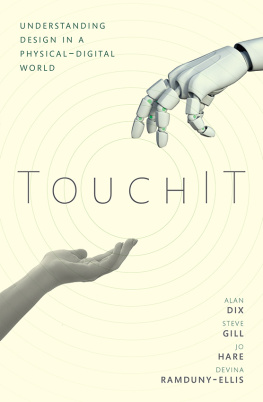ONeill - Pixels and place: connecting human experience across physical and digital spaces
Here you can read online ONeill - Pixels and place: connecting human experience across physical and digital spaces full text of the book (entire story) in english for free. Download pdf and epub, get meaning, cover and reviews about this ebook. year: 2016, genre: Home and family. Description of the work, (preface) as well as reviews are available. Best literature library LitArk.com created for fans of good reading and offers a wide selection of genres:
Romance novel
Science fiction
Adventure
Detective
Science
History
Home and family
Prose
Art
Politics
Computer
Non-fiction
Religion
Business
Children
Humor
Choose a favorite category and find really read worthwhile books. Enjoy immersion in the world of imagination, feel the emotions of the characters or learn something new for yourself, make an fascinating discovery.
- Book:Pixels and place: connecting human experience across physical and digital spaces
- Author:
- Genre:
- Year:2016
- Rating:3 / 5
- Favourites:Add to favourites
- Your mark:
- 60
- 1
- 2
- 3
- 4
- 5
Pixels and place: connecting human experience across physical and digital spaces: summary, description and annotation
We offer to read an annotation, description, summary or preface (depends on what the author of the book "Pixels and place: connecting human experience across physical and digital spaces" wrote himself). If you haven't found the necessary information about the book — write in the comments, we will try to find it.
Pixels and place: connecting human experience across physical and digital spaces — read online for free the complete book (whole text) full work
Below is the text of the book, divided by pages. System saving the place of the last page read, allows you to conveniently read the book "Pixels and place: connecting human experience across physical and digital spaces" online for free, without having to search again every time where you left off. Put a bookmark, and you can go to the page where you finished reading at any time.
Font size:
Interval:
Bookmark:
Praise for
Pixels and Place
The age-old push and pull between form and function in design conversations usually misses a key question: function for whom? Now as the intermingling of online and physical worlds becomes a constant in modern life, its time to address our ability to answer that question. The constant data trail streaming from individual experience can power ever-greater meaning, utility, and profit in daily life if we can just drop the tech buzzwords and realize that through all of it, people just want to do things, feel something, connect, and remember. This is a topic that needs exploring right now and I cant think of a better explorer than Kate ONeill.
Gavin Ivester, founding partner at FLO | Thinkery; former product, design, brand, and innovation leader at Gibson Guitar, Nike, and Apple
We all straddle our "real" and "online" lives with various degrees of success. The rules are being made up as we go along, and it is very difficult to remain completely off the grid and still participate in modern life. Kate O'Neill explores what we are gaining and losing in this transition, and what it means to be human in the digital age.
Tim Ash, CEO of SiteTuners, Author of Landing Page Optimization, and Founder of Conversion Conference
"Pixels and Places" addresses the emerging importance of elements that create human experiences worthy of remembering. To build empathy with users, a design-centric organization empowers employees to observe behavior and draw conclusions about what people want and need. Those conclusions are tremendously hard to express in quantitative language. Instead, organizations that get design use emotional language (words that concern desires, aspirations, engagement, and experience) to describe products and users. "Pixels and Places" lays out the roadmap for thinking to accomplish that aim. Well done and needed by any organization that desires to succeed in the Digital Age.
Jay Deragon, Top 50 over 50 Global Marketing Thought Leaders
Kate ONeills Pixels and Place is a must read for those of us fascinated by the tidal shift taking place around us in the way we envision the world and our experiences within it.
Mitch Lowe, startup advisor, CEO of MoviePass, former president of RedBox, and a founding executive of Netflix
PIXELS
AND
PLACE
Connecting Human Experience
Across Physical and Digital Spaces
by
Kate ONeill
Also by Kate ONeill
Lessons from Los Gatos: How Working at a Startup Called Netflix Made Me a Better Entrepreneur (and Mentor)
Surviving Death: What Loss Taught Me About Love, Joy, and Meaning
Copyright 2016 by Kate ONeill
All rights reserved. No part of this book may be reproduced or transmitted in any form or by any means, electronic or mechanical, including photocopying, recording or by any information storage and retrieval system, without written permission from the author, except for the inclusion of brief quotations in a review.
Published in the United States of America
Acknowledgements
Thank you to everyone who has helped me research, has engaged in endless discussions about meaning and place, and put up with my obsessing over the topics. Big thanks to Sumit Shringi for designing such a wonderful cover. Huge thanks to my editor, Jocelyn Bailey, for her keen eye, the insights she contributed, and her positivity. And an enormous thank you to Robbie Quinn, my photographer and now my husband, whose work I use on the back cover and About the Author page, who makes every place more meaningful for me.
Dedication
To my mother, Georgia, who was my earliest introduction to both of the titular ideas in this book:
a curiosity about computers, and, through her tireless work within our Chicago-area hometown, the value of community and what a place can really mean.
A note on my use of the generic gender-neutral singular pronoun they
Throughout this book, as I describe scenarios involving unspecified actors, instead of the arbitrary use of a single gendered pronoun in generic use, whether he or she, instead of the clunky he/she or wordy he or she, and instead of painstakingly alternating between the uses of gendered pronouns, I have adopted the use of the singular they. It was the American Dialect Societys 2015 word of the year, and it reflects a trend toward more inclusive language. Just like the convergence of pixels and place, youll get used to it.
When you tug at a single thing in the universe, you find it's attached to everything else.
John Muir
All models are false but some are useful.
George E. P. Box
Careful. We don't want to learn from this.
Bill Watterson, Calvin and Hobbes
CHAPTER ONE
A Call to Action
I intend this book as a treatise, a manifesto of sorts, a call to action for anyone who designs experiencesin retail, healthcare, cities, in marketing of all kinds, and so on.
It is framed in the examination of pixels and placeof the convergence of our physical and digital surroundings, experiences, and even identitiesbecause our future is beckoning us forward with little distinction between these layers of our reality, and we need to understand fully what it means to be human within that context. But the underlying message goes further: We need to understand context when we design experiences, because so many experiencesso many web forms, so many stores, so many servicesare presented as if they exist in neatly contained isolation, where every person encountering them is in an identical place and mindset, on an identical screen, when the opposite of that is increasingly true.
This is not just about design for mobile or design for differing screen sizes, although that discussion belongs within the scope of our consideration; this is about recognizing that your brand or offering may be consumed on a laptop today, a phone tomorrow, then on a watch, then by voice command, and perhaps eventually as a passive service prompted by sensory cues needing only the bare minimum of interactions with the human consuming it. This is not a distant future vision; these interfaces and non-interfaces exist today, and their adoption by brands runs the gamut from bleeding-edge to blissfully ignorant. The bleeding-edge are risking and spending a great deal to understand the emerging possibilities, but the blissfully ignorant are taking risks, too: They risk the possibility of becoming out of step with widespread cultural understanding of how digital experiences mesh with our physical surroundings, and eventually, if the brands continue to ignore the trends, they risk irrelevance.
For years Ive been quoting the Peter Drucker line, The aim of marketing is to know and understand the customer so well that the product or service fits [them] and sells itself.
Its not clear what Drucker might have said about big data, connected devices, the Internet of Things, and consumer privacy, but what is clear is that were in an age when these considerations are staring business leaders right in the face. What leaders decide to do with all of it will set a precedent for business in coming years. The generations that follow ours will live with the consequences of whether we built disciplined processes for ourselves and created compelling and meaningful experiences for the humans we interact with, or gave in to the allure of ever-more data and ever-greater invasions of privacy.
The best way for marketing to know the customer now is to truly function as a knowledge center, iterating through efforts to connect with customers, optimizing for insight, seeking to create more meaningful relationships with customers by getting clearer and clearer about what different people value for different reasons.
We need a framework for meaningful experience creation in a world where our personal data is collected invisibly as we pass through our physical surroundings. We need a model for marketing that can be effective without being creepy, to help companies succeed by being relevant and helpful. And we need a mindset to make responsible decisions with each others data because we recognize the humanity it represents, and in doing so, make our possible future together a little bit brighter.
Next pageFont size:
Interval:
Bookmark:
Similar books «Pixels and place: connecting human experience across physical and digital spaces»
Look at similar books to Pixels and place: connecting human experience across physical and digital spaces. We have selected literature similar in name and meaning in the hope of providing readers with more options to find new, interesting, not yet read works.
Discussion, reviews of the book Pixels and place: connecting human experience across physical and digital spaces and just readers' own opinions. Leave your comments, write what you think about the work, its meaning or the main characters. Specify what exactly you liked and what you didn't like, and why you think so.










